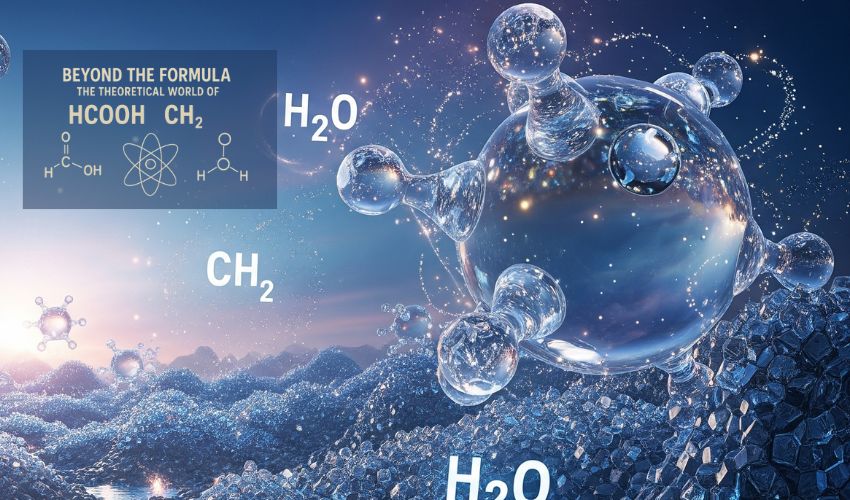Some chemical combinations are particularly noteworthy in the field of organic chemistry because of their importance in both academic and industrial activities. The combination of formic acid (HCOOH), methylene group (CH2), and water (H2O) is known as HCOOH CH2 H2O. Despite having a straightforward composition, this group of molecules offers a basis for comprehending a variety of chemical processes and mechanisms in both commercial and laboratory contexts.
What is HCOOH CH2 H2O ?
Each component must be broken down in order to understand the function of HCOOH CH2 H2O:
- The most basic carboxylic acid, HCOOH, is also referred to as formic acid. It is utilized in the production of chemicals and is extensively present in nature.
- CH2: A methylene group that frequently serves as an organic molecule’s bridge or connection.
- Water, or H2O, is a common solvent and reactant in a wide range of chemical reactions.
These three elements frequently participate in processes including polymer synthesis, oxidation, and hydration. The combination of HCOOH, CH2, and H2O raises the possibility of interactions or coexistence between these substances in a reaction medium.
Chemical Importance of CH2 H2O and HCOOH
The Reactive Acid, HCOOH
The carboxylic acid group of formic acid (HCOOH) makes it extremely reactive. In aqueous solutions, it easily contributes a proton (H⁺) and takes part in processes that are catalyzed by acids. It usually plays a part in acid-base chemistry or oxidation in HCOOH CH2 H2O combinations.
CH2: The Connector of Carbon
CH₂ functions as a component of bigger molecules like methylene bridges or derivatives like methanol, despite not being a stand-alone molecule. The methylene group in HCOOH CH2O2 reactions can originate from either methanol (CH3OH) or formaldehyde (CH2O2), both of which are intermediates in numerous synthetic pathways.
The Universal Medium: H₂O
H₂O, or water, is more than just a solvent. It actively participates in equilibrium, hydration, and hydrolysis reactions. Water frequently affects solubility, reaction rate, and product formation in the setting of HCOOH, CH₂H₂O.
Real-World Uses for HCOOH CH2H2O
Formic Acid’s Industrial Use
HCOOH CH₂ H₂O mixtures can be found in industrial processes such as rubber coagulation, leather tanning, and preservatives. Formic acid’s antimicrobial qualities and biodegradability make it especially valuable.
Methyl Compound Synthesis
Under some circumstances, formic acid and molecules containing methylene can react to produce formaldehyde or methanol. Since water is frequently present during these reactions, HCOOH-CH₂-H₂O could be an intermediate system.
Technology for Fuel Cells
The use of formic acid as a fuel cell hydrogen source is being investigated. HCOOH CH2 H2O may be important for regulated hydrogen release in aqueous environments, where energy transfer is facilitated by CH2-based intermediates.
HCOOH, CH2, and H2O Reactions
Hydrolysis and Esterification
Esters can be created when formic acid reacts with alcohols that come from methylene sources, such as methanol. In these situations, water is either a reactant or a byproduct. A standard esterification could occur next:
- HCOOCH₃ + H₂O ⇌ HCOOH + CH₃OH.
This reversible reaction is a classic example of how HCOOH, CH₂, and H₂O might coexist in a reaction system.
Formation of Formaldehyde
Formaldehyde can also be produced by heating or catalyzing complexes of formic acid and methylene. Once more, water is essential for regulating the reaction conditions.
Safety and Environmental Aspects
Managing Formic Acid
Because it is corrosive, formic acid (HCOOH) needs to be handled carefully. Safety precautions in any system involving HCOOH, CH2H2O include adequate ventilation, protective clothing, and spill-neutralizing chemicals.
Management of Waste
Volatile organic compounds (VOCs) can be produced via reactions involving HCOOH, CH₂, and H₂O. To avoid polluting the air and water, byproduct disposal must adhere to environmental rules.
Context of HCOOH, CH₂, and H₂O in the Lab
Medium of Reaction
HCOOH-CH₂-H₂O mixtures are frequently used as reaction media in laboratories. For example, metal ions are dissolved by formic acid in water, whereas species that include CH2 alter the rate or course of the reaction.
Chemistry in Analysis
These elements may also show up in spectroscopy, chromatography, or titration. In analytical testing, the presence of HCOOH and CH2H2O influences polarity, pH, and detection thresholds.
Upcoming Studies and Developments
As green chemistry gains popularity, scientists are looking into HCOOH CH2H2O systems for environmentally friendly operations. For instance:
- Bio-based synthesis: Making use of methanol and formic acid produced from biomass.
- Creating catalysts that make use of this triad to achieve quicker, cleaner reactions is known as catalytic efficiency.
- Alternative fuels: Formic acid-water solutions are increasingly being used in portable fuel cells.
These directions demonstrate the continued applicability of this ostensibly straightforward combination in intricate, contemporary applications.
Conclusion
Despite not forming a single, stable compound, the combination of HCOOH, CH₂, and H₂O provides an intriguing conceptual framework for comprehending chemical reactivity. With water and formic acid surrounding the unstable methylene group (CH 2), a highly reactive and acidic system would probably result.
In the end, this theoretical exercise emphasizes the basic ideas of chemistry. One can gain a better understanding of how individual molecules react in a solution and how their distinctive qualities can be used for specialized, and in this case, highly theoretical, industrial applications by investigating the hypothetical structure, properties, and applications of HCOOH CH2H2O. This is a potent reminder of the complex and ever-changing realm of chemical synthesis.
FAQ
Is HCOOH CH2H2O a stable chemical compound?
No, it is not a single, stable compound. HCOOH CH2 H2O is a conceptual representation of a chemical system involving formic acid (HCOOH), a highly reactive methylene group (CH2), and water (H2O).
What are the main hypothetical properties of this combination?
The combination would likely be highly acidic and corrosive due to the presence of formic acid. The unstable methylene group would make the mixture extremely reactive, prone to rapid decomposition, and capable of forming new, more stable compounds.
What are some potential applications of this conceptual combination?
In a theoretical sense, its extreme reactivity could make it useful as a rapid catalyst for specific organic reactions or as a specialized, short-lived industrial solvent for aggressive cleaning processes.
Also Read: My Wipro Login: A Step-by-Step Guide

I have hands-on experience in SEO and digital marketing, blending my background in web analytics with a passion for driving measurable growth. Over the years, I’ve worked across on-page, off-page, technical, and local SEO, helping businesses boost traffic, gain visibility, and achieve real results.


